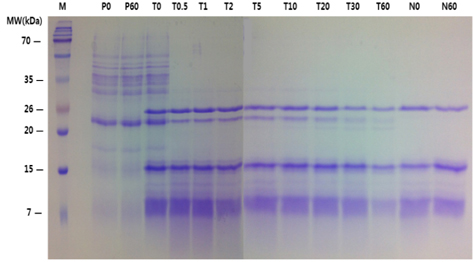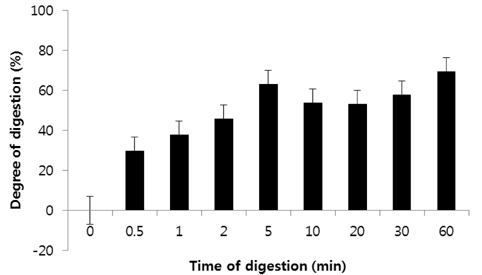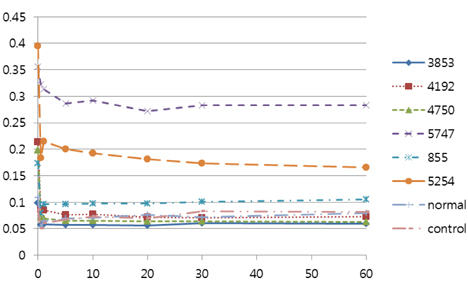Nutr Res Pract.
2013 Feb;7(1):3-8.
Allergenic potential and enzymatic resistance of buckwheat
- Affiliations
-
- 1Department of Food Science and Technology, Ewha Womans University, Daehyeon-dong, Seodaemun-gu, Seoul 120-750, Korea. ssoh71@ewha.ac.kr
- 2Environmental Health Center for Atopic Diseases, Samsung Medical Center, Sungkyunkwan University School of Medicine, Seoul 136-710, Korea.
- 3Korea Food Research Institute, Seongnam, Gyeonggi 463-746, Korea.
Abstract
- Buckwheat is known as a health food but is one of the major food allergens triggering potentially fatal anaphylaxis in Asia, especially in Japan and Korea. This study was conducted to investigate the characteristic of enzymatic resistance of buckwheat protein and allergenic potential. Enzymatic resistance of buckwheat protein was performed with in vitro digestibility test in simulated gastric fluid (SGF), pH 1.2, using pepsin and simulated intestinal fluid (SIF) using chymotrypsin. Reactivity of buckwheat proteins to human IgE was performed using six allergic patients sensitized to buckwheat. Buckwheat's IgE levels were measured using the Phadia UniCAP-system. Buckwheat protein, 16 kDa, still remained after 30 min treatment of pepsin on SDS-PAGE. Even though 16 kDa almost disappeared after 60 min treatment, two out of the six buckwheat patients' sera showed reactivity to hydrolysate after 60 min treatment, indicating that allergenicity still remained. In simulated intestinal fluid (SIF) using chymotrypsin, buckwheat protein, 24 kDa, showed resistance to hydrolysis with chymotrypsin on SDS-PAGE, and still had allergenicity based on the result of ELISA. Our results suggest that buckwheat proteins have strong resistance to enzyme degradation. This may be attributed in part to the allergenic potential of buckwheat. Further study should be continued regarding buckwheat allergy.
Keyword
MeSH Terms
Figure
Reference
-
1. Wieslander G, Norbäck D. Buckwheat allergy. Allergy. 2001. 56:703–704.
Article2. Park CH, Choi YS. Memil. 2004. Chuncheon: Kangwon National University Publishing Co.;35–43.3. He J, Klag MJ, Whelton PK, Mo JP, Chen JY, Qian MC, Mo PS, He GQ. Oats and buckwheat intakes and cardiovascular disease risk factors in an ethnic minority of China. Am J Clin Nutr. 1995. 61:366–372.
Article4. Choe M, Kim JD, Park KS, Oh SY, Lee SY. Effect of buckwheat supplementation on blood glucose levels and blood pressure in rats. J Korean Soc Food Nutr. 1991. 20:300–305.5. The Korean Academy of Asthma. Allergy and Clinical Immunology, 4 Chunmanyoi Allergy. 2005. Seoul: Yoihakmunhwasa Publishing Co.;85–92.6. Smith HL. Buckwheat-poisoning with report of a case in man. Arch Intern Med (Chic). 1909. 3:350–359.7. Son DY, Yoon KR, Lee SI. Study of the most common allergic foods in Korea. Korean J Food Sci Technol. 2002. 34:885–888.8. Houben GF, Knippels LM, Penninks AH. Food allergy: predictive testing of food products. Environ Toxicol Pharmacol. 1997. 4:127–135.
Article9. Tanaka K, Matsumoto K, Akasawa A, Nakajima T, Nagasu T, Iikura Y, Saito H. Pepsin-resistant 16-kD buckwheat protein is associated with immediate hypersensitivity reaction in patients with buckwheat allergy. Int Arch Allergy Immunol. 2002. 129:49–56.
Article10. Kruger NJ. Walker JM, editor. The bradford method for protein quantitation. The Protein Protocols Handbook. 2002. 2nd ed. Totowa: Humana Press Inc.;15–21.
Article11. Kato H, van Chuyen N, Utsunomiya N, Okitani A. Changes of amino acids composition and relative digestibility of lysozyme in the reaction with alpha-dicarbonyl compounds in aqueous system. J Nutr Sci Vitaminol (Tokyo). 1986. 32:55–65.
Article12. Keum EH, Lee SI, Oh S. Effect of enzymatic hydrolysis of 7S globulin, a soybean protein, on its allergenicity and identification of its allergenic hydrolyzed fragments using SDS-PAGE. Food Sci Biotechnol. 2006. 15:128–132.13. Laemmli UK. Cleavage of structural proteins during the assembly of the head of bacteriophage T4. Nature. 1970. 227:680–685.
Article14. Matsumoto R, Fujino K, Nagata Y, Hashiguchi S, Ito Y, Aihara Y, Takahashi Y, Maeda K, Sugimura K. Molecular characterization of a 10-kDa buckwheat molecule reactive to allergic patients' IgE. Allergy. 2004. 59:533–538.
Article15. Park JW, Kang DB, Kim CW, Ko SH, Yum HY, Kim KE, Hong CS, Lee KY. Identification and characterization of the major allergens of buckwheat. Allergy. 2000. 55:1035–1041.
Article16. Nair A, Adachi T. Immunodetection and characterization of allergenic proteins in common buckwheat (Fagopyrum esculentum). Plant Biotechnol (Tsukuba). 1999. 16:219–224.
Article17. Kondo Y, Urisu A, Wada E, Tsuruta M, Yasaki T, Yamada K, Masuda S, Morita Y. Allergen analysis of buckwheat by the immunoblotting method. Arerugi. 1993. 42:142–148.18. Urisu A, Kondo Y, Morita Y. Identification of a major allergen of buckwheat seeds by immunoblotting methods. Allergy Clin Immunol News. 1994. 6:151–155.19. Han Y, Kim J, Ahn K. Food allergy. Korean J Pediatr. 2012. 55:153–158.
Article20. Yoshimasu MA, Zhang JW, Hayakawa S, Mine Y. Electrophoretic and immunochemical characterization of allergenic proteins in buckwheat. Int Arch Allergy Immunol. 2000. 123:130–136.
Article21. Satoh R, Koyano S, Takagi K, Nakamura R, Teshima R. Identification of an IgE-binding epitope of a major buckwheat allergen, BWp16, by SPOTs assay and mimotope screening. Int Arch Allergy Immunol. 2010. 153:133–140.
Article22. Allergens of Buckwheat. IUIS Allergen Nomenclature [Internet]. cited 2012 July 14. Available from: http://www.allergen.org/.23. Takagi K, Teshima R, Okunuki H, Sawada J. Comparative study of in vitro digestibility of food proteins and effect of preheating on the digestion. Biol Pharm Bull. 2003. 26:969–973.
Article24. Koyano S, Takagi K, Teshima R, Sawada J. Molecular cloning of cDNA, recombinant protein expression and characterization of a buckwheat 16-kDa major allergen. Int Arch Allergy Immunol. 2006. 140:73–81.
Article25. Satoh R, Koyano S, Takagi K, Nakamura R, Teshima R, Sawada J. Immunological characterization and mutational analysis of the recombinant protein BWp16, a major allergen in buckwheat. Biol Pharm Bull. 2008. 31:1079–1085.
Article
- Full Text Links
- Actions
-
Cited
- CITED
-
- Close
- Share
- Similar articles
-
- Effects of enzymatic hydrolysis of buckwheat protein on antigenicity and allergenicity
- Dermatophagoides Farinae, an Important Allergenic Substance in Buckwheat-Husk Pillows
- Identification and characterization of buckwheat allergen
- Three Cases of Buckwheat Allergy
- Buckwheat allergy in adults: comparison of specific IgE between homemade ELISA and CAP system, and identification of IgE-binding components







